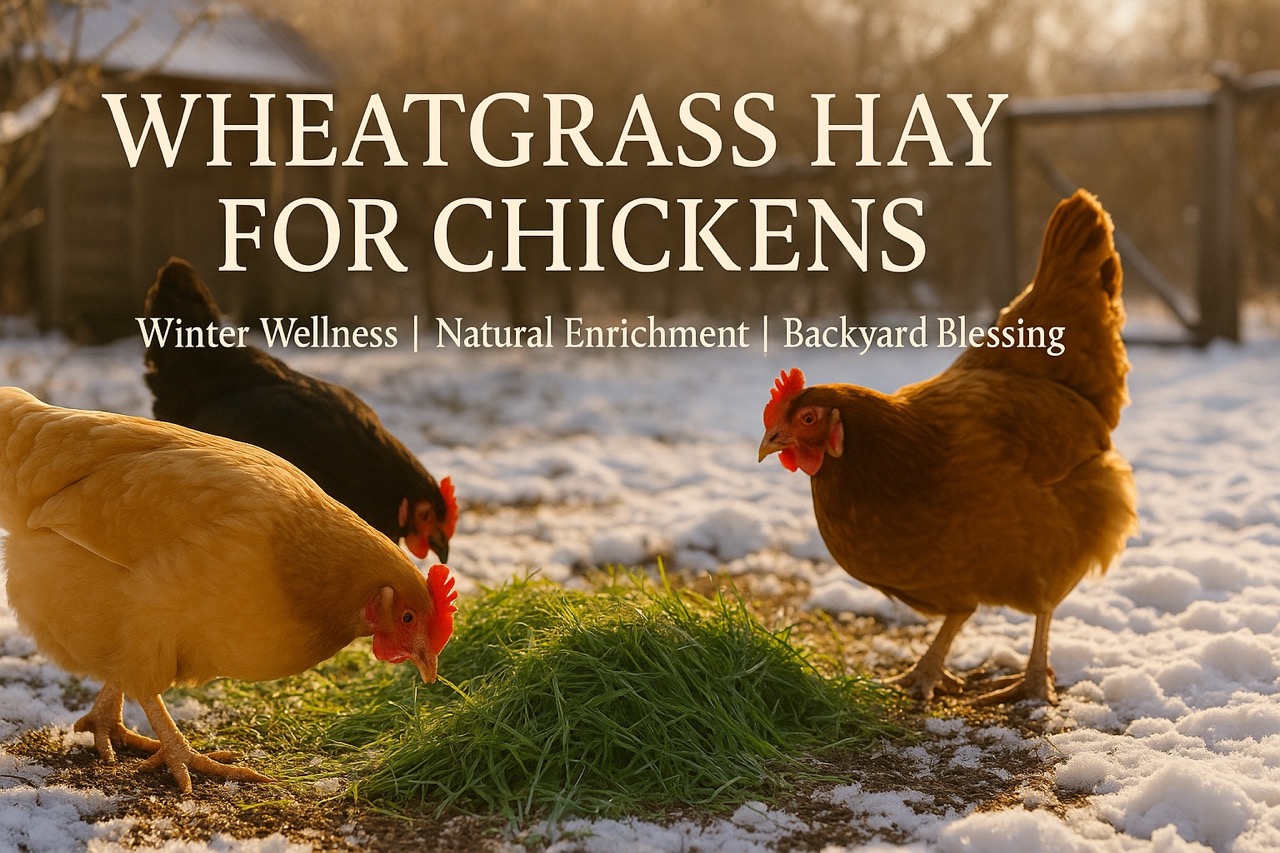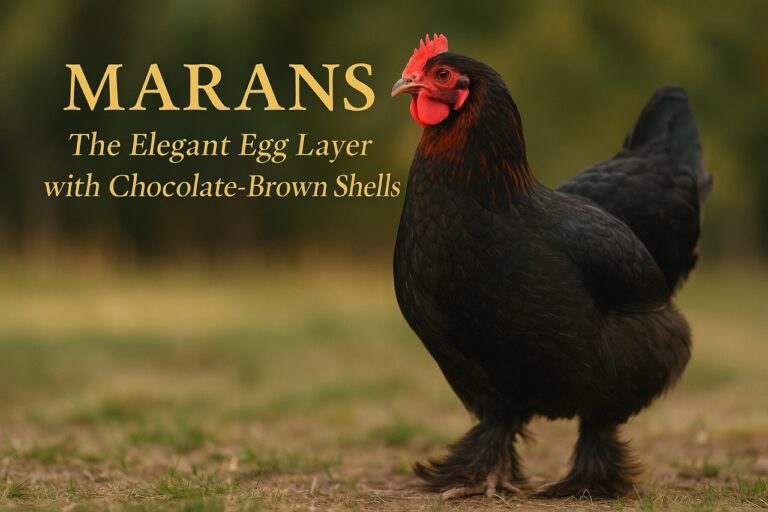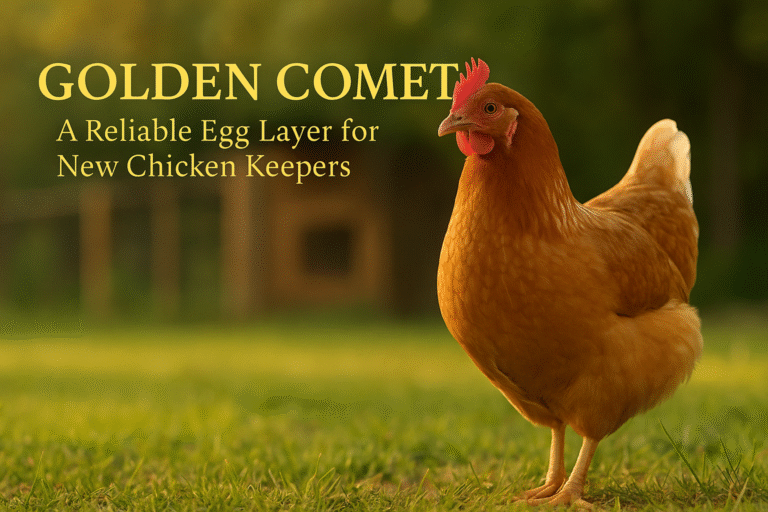As winter approaches, keeping backyard chickens healthy, comfortable, and engaged becomes a challenge. One powerful yet simple solution? Wheatgrass hay for chickens. This superfood supplement supports winter wellness by offering critical nutrients, mental stimulation, and natural insulation. Here’s how it works—and how to use it.
🥬 Nutritional Benefits of Wheatgrass Hay
When cold weather limits foraging and greens, wheatgrass hay becomes a nutrient-rich ally:
- Rich in Vitamins A, B, C, and E – These immune-boosting vitamins help chickens stay healthy in winter. Cornell University highlights wheatgrass’s benefits in poultry immune function and feather maintenance.
- Natural Protein Source – Supports egg production and laying cycles. University of Kentucky notes that extra winter protein maintains consistent egg output.
- High in Fiber – Encourages digestion and reduces the risk of crop impaction. University of Minnesota Extension recommends fibrous forage for gut health.
👉 Tip: Use wheatgrass hay as a supplement—not a replacement—for balanced layer feed.
🧠 Mental & Physical Enrichment
Boredom leads to pecking, stress, and lethargy in winter. Wheatgrass hay combats this with natural enrichment:
- Promotes Natural Foraging – Chickens scratch, peck, and dig through hay, activating natural instincts. Backyard Poultry recommends using hay to encourage exploratory behaviors.
- Stimulates the Senses – The texture, scent, and variety of hay reduce stress and keep birds mentally engaged.
👉 Tip: Create “foraging zones” by spreading hay throughout the run or coop.
🛌 Warmth and Insulation
Wheatgrass hay isn’t just feed—it’s functional bedding too:
- Insulates the Coop – Acts as a barrier against cold ground, helping chickens conserve body heat. Modern Farmer ranks hay among the best natural winter bedding materials.
- Comfortable Nesting – Soft and warm for roosting and egg-laying.
👉 Tip: Rotate hay regularly to prevent mold, ammonia, and respiratory issues.
🥦 A Green Substitute When Forage Is Gone
Wheatgrass hay mimics the freshness of pasture greens:
- Alternative to Fresh Greens – Offers similar nutrients when outdoor foraging isn’t possible. Hobby Farms recommends hay for winter diet diversity.
- Chlorophyll Boost – Maintains egg yolk brightness and chicken vitality.
👉 Tip: Rotate wheatgrass with other hays (like alfalfa or timothy) for nutrient variety.
🐞 Natural Pest Control and Soil Enrichment
Wheatgrass hay supports coop health and spring gardening too:
- Attracts Beneficial Insects – Provides natural snacks for chickens.
- Improves Soil – Scratched hay + droppings = composted soil enrichment. American Pastured Poultry Producers Association supports this natural cycle.
👉 Tip: Add hay to compost or mulch runs for long-term garden benefits.
📋 How to Use Wheatgrass Hay in the Coop
- Spread in Thin Layers – Prevent moisture buildup and reduce rot
- Inspect for Mold – Never use damp or moldy hay
- Replace Regularly – Every 1–2 weeks to avoid ammonia and mess
- Use Hay Feeders – Hanging hay feeders keep hay dry and reduce waste
🐔 Frequently Asked Questions – Wheatgrass Hay for Chickens
🌿 What are the winter benefits of wheatgrass hay for chickens?
Wheatgrass hay provides vital nutrition and enrichment when fresh greens are unavailable. It contains:
- Immune-boosting vitamins (A, B, C, E) to fight cold-season illnesses
- Natural protein to support consistent egg laying
- Dietary fiber for healthy digestion and reduced crop issues
It also encourages activity during long, inactive winter days, promoting overall health and well-being.
🍽️ Can wheatgrass hay replace regular layer feed?
No. Wheatgrass hay is a supplement, not a replacement. While it provides nutrients, chickens still need a balanced layer feed for:
- Correct calcium levels for strong eggshells
- Complete protein for muscle maintenance and reproduction
- Vital minerals and energy requirements
Use wheatgrass hay as an enhancement to promote natural foraging and provide roughage, not as a full dietary replacement.
🧠 How does wheatgrass hay improve chicken behavior in winter?
Cold months often lead to boredom, stress, and pecking aggression due to reduced daylight and limited foraging. Wheatgrass hay helps by:
- Stimulating natural pecking and scratching behavior
- Offering new textures and scents for sensory enrichment
- Encouraging social exploration through scattered hay piles or feeders
This reduces restlessness and encourages a calm, healthy flock dynamic.
🪵 Can I use wheatgrass hay as bedding in the coop?
Yes! Wheatgrass hay is an excellent dual-purpose material that serves as both enrichment and warm, comfortable bedding. Benefits include:
- Natural insulation to help retain coop warmth
- Soft nesting material for comfort and egg laying
- Pleasant scent and texture chickens love
Just be sure to keep it dry and rotate frequently to prevent mold and ammonia buildup.
🌱 Does wheatgrass hay help improve garden soil?
Absolutely. Chickens naturally shred, scatter, and compost wheatgrass hay as they interact with it. This creates:
- Rich organic matter from decomposed hay and droppings
- A base for spring garden beds or compost piles
- A natural way to recycle waste and build soil structure
Try turning over spent hay into your spring garden for a nutrient-rich start.
💨 How do I prevent wheatgrass hay from getting moldy?
Mold is dangerous for chickens and must be avoided. Here’s how to keep wheatgrass hay fresh and safe:
- Inspect hay before use for moisture or musty smells
- Spread it in thin layers across dry bedding or run areas
- Use a hanging feeder to keep hay off the ground in wet weather
- Rotate and refresh hay every 1–2 weeks to prevent buildup and ammonia gas
🌼 What’s the difference between wheatgrass hay and regular hay?
Wheatgrass hay is typically softer, more nutrient-dense, and richer in chlorophyll than traditional grass or straw hays. It’s ideal for:
- Chickens needing extra greens
- Flock keepers wanting to boost egg nutrition and yolk color
- Use as both forage and comfort material
Traditional hay like timothy or alfalfa may still be used, but wheatgrass hay offers more winter-specific benefits.
🐓 Related Reading on Paranoid Prophet
- Chicken Dust Baths: Essential for Your Flock’s Health
Dust baths aren’t just fun—they’re critical for hygiene and pest control. Learn how to create the ultimate dirt spa for your chickens. - Winter Chicken Memes and Facts
Discover practical cold-weather tips and fun flock facts to keep your chickens happy and entertained during winter. - Backyard Chickens and Sustainability
Learn how chickens help create a closed-loop ecosystem that reduces waste and regenerates your garden naturally. - Chickens and Natural Pest Control
Your chickens can help control ticks, flies, and garden pests—all while scratching and fertilizing your soil.
Sources
- Wow, Chickens Love Wheatgrass
- A forum thread from Backyard Chickens where users share their experiences with growing and feeding wheatgrass to chickens, highlighting its popularity among backyard flocks. Backyard Chickens – Wow, Chickens Love Wheatgrass
- How to Grow Wheat Grass for Chickens
- This guide from The Cape Coop explains how to grow wheatgrass specifically for chickens, offering tips on planting, harvesting, and providing fresh wheatgrass for your flock. The Cape Coop – How to Grow Wheat Grass for Chickens
- Superfood for Chickens: Wheatgrass
- Bitchin’ Chickens explores the benefits of wheatgrass as a superfood for chickens, covering its nutritional profile and how it can boost your flock’s health. Bitchin’ Chickens – Superfood for Chickens: Wheatgrass
🌾 A Final Reflection
Wheatgrass hay is more than just winter filler — it’s a bridge between seasons. When your chickens can’t forage, this green gift brings nourishment, comfort, and enrichment into their coop. It’s a reminder that even in times of scarcity, creation still offers provision — if we’re willing to steward it well.
As you lay hay in the run or coop, you’re not just feeding chickens — you’re partnering with nature’s quiet rhythms. And that’s a form of care worth honoring.




